Exploring Cuffless Blood Pressure Estimation Using the TransfoRhythm Framework
Overview of Research
This paper introduces a novel attention-based Deep Neural Network (DNN) architecture termed the "TransfoRhythm" to estimate blood pressure (BP) from photoplethysmography (PPG) signals. The research employs the recently released MIMIC-IV dataset, marking a significant development in the application of attention mechanisms for cuffless BP monitoring. By leveraging Multi-Head Attention (MHA), the proposed model is designed to capture the rich temporal dynamics and variations in PPG signals, thus enhancing the prediction accuracy of systolic and diastolic blood pressure (SBP and DBP).
Methodology
The TransfoRhythm framework utilizes an advanced neural architecture strategy combining MHA with position embeddings and a time compressor for effective feature translation into BP estimates. The model processes input data through several bespoke preprocessing and feature extraction stages, ensuring that inputs are robust and reflective of significant physiological signals. The architecture of the model supports parallel processing of inputs, crucial for handling the large volumes of data typical in healthcare applications.
Data Handling
The framework employs the MIMIC-IV dataset comprising 198 individual records with PPG, ECG, and invasive arterial blood pressure (ABP) signals. The preprocessing pipeline includes steps for noise reduction, signal smoothing via Butterworth and Moving Average Filters, and artifact removal, ensuring high-quality inputs for the DNN model.
Feature Engineering
Twelve features are extracted from the PPG waveforms focusing on temporal characteristics and morphological attributes which are vital for capturing the waveform dynamics associated with BP changes. These features include cycle duration, peak-to-notch durations, and integrative metrics over defined parts of the PPG waveform.
Results and Performance Evaluation
The TransfoRhythm framework demonstrated high accuracy in BP estimation with mean R-squared values above 0.991 for both SBP and DBP, and low error metrics (MAE and RMSE) across both measurement categories. Performance metrics closely adhere to both AAMI and BHS standards, underscoring the model's utility in clinical settings.
Benchmark Comparisons
Comparative analyses against other deep learning models using the same dataset highlight the superior predictive capability of TransfoRhythm, with significant improvements noted in MAE and RMSE values compared to established benchmarks like ResNet1D, U-Net, and hybrid CNN-RNN models.
Practical Implications and Theoretical Contributions
The TransfoRhythm model's strong performance suggests significant practical applications, particularly in continuous, non-invasive blood pressure monitoring, potentially enhancing patient care in settings where traditional cuff devices are impractical. Theoretically, the work extends knowledge on the efficacy of attention mechanisms in medical signal processing, particularly in modeling time-series data such as PPG signals where traditional methods might falter.
Future Directions
While the current paper prominently showcases the potential of MHA in healthcare, future research might explore hybrid models integrating RNN and CNN features, use larger datasets for training and validation, or extend applications to other physiological signal estimations. Further refining the model to address diverse patient demographics or different health conditions could enhance its robustness and applicability in global health contexts.
Conclusion
In conclusion, the TransfoRhythm framework marks a robust advancement in the use of deep learning technologies for health monitoring, specifically leveraging MHA within a blood pressure estimation context from PPG signals. Its success opens avenues for more personalized, efficient, and non-invasive health monitoring solutions, crucial for modern healthcare infrastructures.
